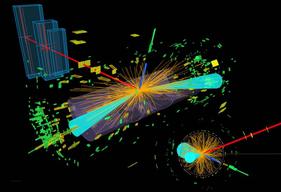
The answer returned from the podium was a little short, bringing to my personal vault of paranoia a ringing reminder of what happened at the Paris Cosmology Colloquium (covered in Quantumology). Apparently, you don't find Taus in everyday existence because they don't exist for long enough to be part of everyday life. So I went out to the foyer after the lectures, where an array of illustrative objects and experiments had been laid out, and investigated further. If electrons are thought to live as long as the Universe, or thereabouts, how come the Tau, being of the same family, hardly exists for any time at all? What's the connection?

Neutrinos oscillate from one form to another without suffering any apparent after-effects such as death. But the other leptons, electrons excepted, are too heavy to withstand the pressure of living in this Universe without collapsing under their own weight, and decaying (the scientific term for falling to bits) into other particles. This from Wikipedia (laugh if you want, but send a complaint only if it's wrong):
"The tau is the only lepton that can decay into hadrons – the other leptons do not have the necessary mass. Like the other decay modes of the tau, the hadronic decay is through the weak interaction.
The branching ratio of the dominant hadronic tau decays are:
25.52% for decay into a charged pion, a neutral pion, and a tau neutrino;
10.83% for decay into a charged pion and a tau neutrino;
9.30% for decay into a charged pion, two neutral pions, and a tau neutrino;
8.99% for decay into three charged pions (of which two have the same electrical charge) and a tau neutrino;
2.70% for decay into three charged pions (of which two have the same electrical charge), a neutral pion, and a tau neutrino;
1.05% for decay into three neutral pions, a charged pion, and a tau neutrino.
In total, the tau lepton will decay hadronically approximately 64.79% of the time.
Since the tauonic lepton number is conserved in weak decays, a tau neutrino is created when a tau decays to a muon or an electron."
Which is just a list of the discovered bits a tau will turn into when it's fallen apart. This, again from Wikipedia, explains what a Pion is:
"In particle physics, a pion (short for pi meson, denoted with p) is any of three subatomic particles: p0, p+, and p-. Each pion consists of a quark and an antiquark and is therefore a meson. Pions are the lightest mesons and they play an important role in explaining the low-energy properties of the strong nuclear force.
Pions are unstable, with the charged pions p+ and p- decaying with a mean life time of 26 nanoseconds and the neutral pion p0 decaying with an even shorter lifetime. Charged pions tend to decay into muons and muon neutrinos, and neutral pions into gamma rays."
You can see from this, that pions, made of quarks, themselves fall to bits very quickly (26 nanoseconds is less than a standard blink, by a long shot) and they turn into muons, muon neutrinos and gamma rays. So in all this lurks another quandary. Where does all this falling-to-bits actually end? Is it a case of ‘out of sight, out of mind'? We know about gamma rays, but is there a further outer-space to the electromagnetic spectrum we don't yet know about? Just because something is on the edge of our line of sight doesn't mean there isn't more over our shoulder.
There was another thing to come out of this evening's lectures which I found rather palatable. The LHC has an experiment running called the ‘LHCb' - and the ‘b' stands for ‘beauty'. As in ‘beauty', partner of ‘truth', those perspicacious quark names which were dropped in deference to ‘bottom' and ‘top'. Regular readers will know that I found the whole business of quark anti-christening very distasteful indeed, so I was thrilled when Nazim mentioned the LHC Beauty experiment in his talk. He said at the time he'd come back to it later, so I waited breath bated, but he didn't, so when the lecture closed I asked,
"As Bottom used to be Beauty, and you've mentioned the LHC Beauty experiment, is there any connection here with the Beauty quark?"
And yes, there certainly was, because the Beauty quark apparently has some strange quirks of symmetry to it which the particle physicists are keen to unravel. For sure I'll be doing some unravelling of my own, then, and finding out more about this quarkish adventure. Watch this space. I'll come back to it later.
 RSS Feed
RSS Feed
